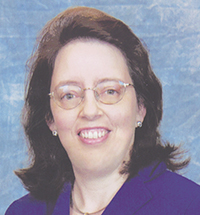Accurate and timely diagnoses are critical components for developing treatment plans for patients with cancer and also for informing prognosis and assessment of responses. Pathologists are an essential part of the oncology team because they have specialized knowledge that helps inform diagnostic test selection, performance, and interpretation. To shed light on the role of pathologists in the cancer continuum, The ASCO Post recently spoke with Sharyl Nass, PhD, Director of the Board on Health Care Services and Director of the National Cancer Policy Forum at the National Academies of Sciences, Engineering, and Medicine.

Photo credit: Getty
Neutral Convener
Please tell us about your current position and work.
I direct the National Cancer Policy Forum at the National Academies of Sciences, Engineering, and Medicine. We serve as a neutral convener for a broad range of experts and stakeholders in cancer policy. We examine policy issues across the entire spectrum of basic, translational, and clinical research and the whole range of care from diagnosis, treatment, palliative care, survivorship, and end-of-life care. The core mission of the National Academies is to provide independent, objective analysis and advice to the nation to solve complex problems and inform public policy decisions related to science, technology, and medicine.
Inadequate Evidence-Based Guidance for Oncologic Tests
Please talk about the lack of evidence-based guidelines to aid test selection and interpretation.

Sharyl Nass, PhD
Certain tests are indicated in U.S. Food and Drug Administration labels for some oncology drugs, which are meant to guide treatment selection. Although groups such as the National Comprehensive Cancer Network make recommendations for assessments of particular biomarkers, they generally do not specify tests; thus, there may be many different options for measuring a particular diagnostic marker. How the various tests are interpreted can also be quite different. Given the fast pace of new advances in testing and the sheer volume of tests, treating clinicians may not be familiar with all of the various tests, so that produces dissimilarity in how they approach testing and act upon the results.
Moreover, laboratories have a variety of platform options for a particular test and might apply different thresholds for interpretation of results as positive or actionable. Test selection may also vary by histologic subtype, stage of disease, and previous response to therapies. To date, there are few evidence-based guidelines and limited clinical decision support to help with test selection and interpretation.
Challenges Surrounding Complexity of Oncology Reports
You have looked at the complexity of diagnostic pathology reports with the advent, for one, of molecular testing. Where are we on that front? Given the early hiccups, how do electronic health records play a part in this multistep process?
Unfortunately, that is still more aspirational than implemented at this time. People are working on ways to better integrate genomic and genetic information into electronic health records, but, even when we get there, it’s still a big step to integrate other complex diagnostic tools such as state-of-the-art imaging into these systems. Right now, there is no informatics-based way to do that; it really has to be done by clinicians themselves, which also poses problems because of varying levels of expertise. Pathologists have deep specialization and proficiency in the tests they’re doing, as do radiologists; however, treating oncologists receive all of this information from different experts, and they are not trained in informatics of other specialties, so it presents a challenge for them to integrate and interpret the information they receive.
We need to leverage technologies such as artificial intelligence, which can be used to develop algorithms that parse out this complex information and provide a more consistent interpretation that can be translated into clinical care. In other words, greater integration of pathology and radiology reports in oncology would provide a more unified and complete interpretation of a patient’s disease, with implications for treatment planning and management as well as for monitoring response to therapy.
"We need to leverage technologies such as artificial intelligence, which can be used to develop algorithms that parse out this complex information and provide a more consistent interpretation that can be translated into clinical care. In other words, greater integration of pathology and radiology reports in oncology would provide a more unified and complete interpretation of a patient’s disease, with implications for treatment planning and management as well as for monitoring response to therapy."— Sharyl Nass, PhD
Tweet this quote
MSK Model
Could you describe the Memorial Sloan Kettering Cancer Center (MSK) model to improve patient access to high-quality oncologic pathology and how it might be generalized across other centers?
MSK uses a tumor board model, which is reserved for unusual and complex cases, such as bone cancer, which cannot be accurately diagnosed simply by a pathology or radiology report. So, an integrated report is prepared for patients with bone cancer via tumor boards that may include many different experts in the room, along with the treating oncologist. The experts provide their opinion based on the test results they have, but again, treating oncologists have to process a huge amount of information derived from experts in different disciplines and synthesize it into a decision-making process.
MSK can do this because they have so many clinicians with deep expertise in these different specialty areas, plus the capacity to bring them together. Most other institutions, especially in community care settings, are not able to accomplish this, not only because they don’t have the numbers of experts at hand, but also because there is no payment mechanism to cover the costs. There’s no CPT code for participating in a tumor board and providing expert input into a patient’s diagnosis and treatment options. That’s why there is a need to foster better connections between community practices and the large tertiary cancer centers, which do have the deep specialized expertise to provide equal high-quality care across different settings. But again, there’s currently no payment mechanisms to facilitate these interactions.
How do super-busy community practices optimize these tests and manage to keep up with the rapidly evolving technology?
That’s an excellent question, and in general, it is very difficult for community practitioners to keep up with evolving diagnostic tests. Moreover, most community-based clinicians practice as generalists, so their hands are full already keeping up with new therapies and treatment regimens emerging from the pipeline for a wide-array of cancers. Again, that’s why it’s necessary to develop means by which community practices can access the expertise at institutions such as MSK.
Future Steps
Any closing thoughts?
There is tremendous potential to improve patient outcomes if we can devise a feasible and affordable way to get precise, integrated diagnostics to guide decisions across the entire cancer care spectrum. To get there, we need action from policymakers and leaders in pathology, radiology, informatics, and oncology. Our siloed care delivery system poses additional challenges, but it’s a critical step in achieving better outcomes for our patients with cancer, so we need to keep moving forward.
DISCLOSURE: Dr. Nass has received institutional research funding for the National Cancer Policy Forum from Bristol-Myers Squibb, Flatiron Health, Helsinn Healthcare, Merck, Novartis, and Pfizer.

